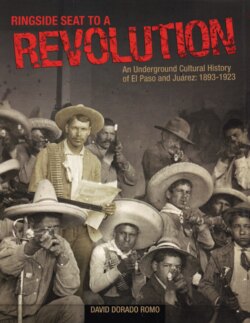Читать книгу Ringside Seat to a Revolution - David Dorado Romo - Страница 32
На сайте Литреса книга снята с продажи.
Оглавлениеhim to believe that such a marriage will
occur. I have only met him 2 or 3 times and
my occupation gives me no time for love
affairs. Mr. Rodríguez has spoken several
times with my father. I know not on what
subjects. I can only imagine my father has
not a good opinion of him and therefore has
not encouraged his matrimonial pretensions.
I would thank Dr. Rodríguez for his preten-
sions if they were sane, but I believe he makes
them to injure me before the public.”32
But Teresita was not
just a celebrity at the local
level. Her fame spread
like wildfire throughout
the rest of the United
States as well. Newspaper
correspondents came to
the border from San
Francisco, Austin and
New York to interview
the young Mexican mira-
cle worker. Later, when
she left El Paso and
toured throughout the
United States, she also
made headlines wherev-
er she went. Journalists
were almost always
struck by Teresita’s mod-
esty and sincerity. “She
doesn’t pose; she doesn’t
persuade; she only
answers questions in a
straightforward, unhesitating way never dodging,
never resisting, never for a moment trying to hide
anything or explain away anything,” wrote Helen
Dare of the San Francisco Examiner. “The glance of
her beautiful brown eyes is half sad and wholly intel-
ligent, without any of the cunning or the sleepiness
or the furtive watchfulness of the ordinary Mexican or
Indian,” the reporter added using racial stereotypes
typical of her day.33
Many of the out-of-town journalists who visited
Teresita in the Segundo Barrio reported that they
thought some kind of healing was actually taking
place, but they all had different explanations for this
phenomenon. Maud Mason, a news correspondent
from Austin, Texas, declared Teresita, without knowing
it, was using the techniques of some of the best known
hypnotists in the world. Although Teresita “does not
have any education, and could not have read Delenze,
or Mayor, or Tester, or Carpenter, or could have ever
heard of Franz Anton Mesmer,” Mason wrote with a
mixture of admiration and condescension, “her
method is theirs.”34 Another “unprejudiced” observer
who claimed “some knowledge of physics” concluded
that Teresita’s powers
were based on “animal
magnetism combined with
electricity and Odyllic
forces, of which any stu-
dent can inform himself
by perusing the latest
works on physics and
electricity.”35
Many of Teresita’s heal-
ing methods, however,
were grounded less on
“Odyllic forces” (whatev-
er that means) and more
on the indigenous culture
that she had grown up
with. She had been a
healer since her early
adolescence. While at her
father’s ranch in Cabora,
Teresita had been the
apprentice of a Yaqui
curandera named Huila.
From her, Teresa learned
the medicinal uses of more than 200 herbs and folk
remedies. Teresita’s half-sister, Anita, recalled Teresita
putting yerba galandrina on the back of her head
after she had been bit by a scorpion.36 Many of these
natural remedies are still used among the Indian com-
munities along Mexico’s northern border today. Yerba
del indio from the mountains of Chihuahua is said to
relieve stomach ailments; yerbanís works for coughs;
yerba del arriero with a bit of pomegranate rind is
excellent for child’s diarrhea; yerba de la víbora, to
this day, is used by the Tarahumara to offer relief
from the common cold.37
27
“The glance of her beautiful
brown eyes is half sad and
wholly intelligent…she has in
her modest, fragile person and
her quiet manner such a
dignity, such earnestness, and
sincerity and gentleness and
serenity that one cannot deny
her respect.”
—California journalist Helen Dare
32
El Paso Times, November 20, 1896.
33
“Santa Teresa, Celebrated Mexican Healer, Whose Powers Awe Warlike Yaquis in Sonora, Comes to Restore San Jose Boy to Health,” the San
Francisco Examiner, July 27, 1900.
34
El Paso Times, September 9, 1896.
35
El Paso Times, June 17, 1896.
36
Anita Urrea Treviño, interview by William Holden, Nov. 23-24, 1961. Holden Collection, Texas Tech University.
37
Osorio, Tomóchic en llamas, p. 43.
